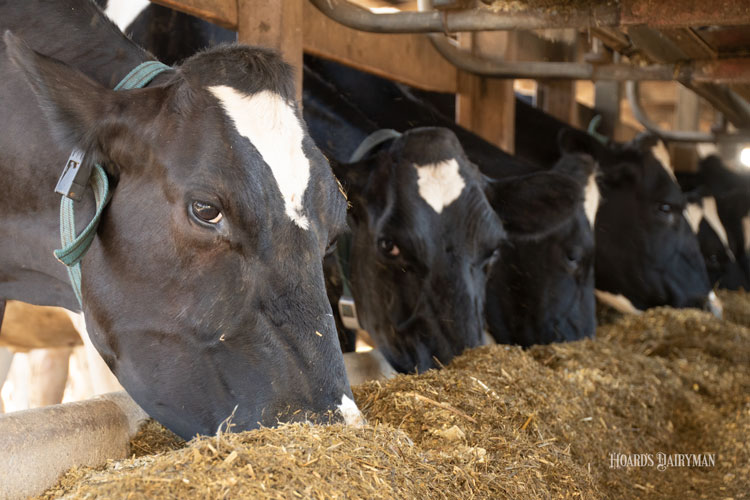
As corn and soybean prices continue to climb upward, farmers may have some difficult decisions to make when it comes to rations for the dairy herd. Mike Hutjens, a professor at the University of Illinois, says to proceed with caution when making changes. He offered a few pieces of advice during the April Hoard’s Dairyman webinar, “Feeding cows with $5 corn and $450 soybean meal.”
His first take-home message was that dry matter counts. “You only get to set peak milk once,” he explained. “If the price of corn goes down in August or September due to a great crop season, I am sorry; but for those cows that got a low lactation start, you can’t change that anymore.”
Beyond milk yield, Hutjens said that high-producing cows are the most feed efficient cows in your herd. Aim for more than 1.5 pounds of milk per pound of dry matter consumed. High-producing, mature cows will approach 1.7 to 1.8 pounds of milk per pound of dry matter. Feed efficiency less than 1.3 pounds of milk per pound of dry matter is concerning, Hutjens said.
His second point was that milk components also count. “Protein is twice the value of fat right now. I am not going to give up any protein,” he shared. Hutjens said to target over 5.5 pounds of combined pounds milkfat and milk protein; elite herds will be over 7 pounds per cow per day. “Every dairy farmer has to know that number,” Hutjens advised.
Next, he said to assess starch utilization. This can be done by evaluating grain particle size. The target for dry corn is 400 to 800 microns, and for wet corn over 26% moisture, it is greater than 1,600 microns. Kernel processing scores should be over 70%, and fecal starch levels should be below 4%.
His fourth recommendation is to fine-tune milk urea nitrogen (MUN) levels. “My target is 8 to 12,” he shared. If the number gets much below 8, more rumen degradable protein may be needed. If too far over 12, there may be negative impacts to fertility, reduced nitrogen efficiency, and environmental risks.
The next step is to review forage quality. “Neutral detergent fiber digestibility (NDFD) will be important when considering forage to concentrate ratios,” Hutjens noted. He said to think about forage hybrids that lead to higher NDFD values.
Hutjens encouraged farms to lock in forage quality for 2021 since grain prices may remain high, and quality forages could reduce the quantity of grain needed. He reminded the audience that high corn silage-based diets can provide 45% of the cows total starch requirement.
Finally, he said to review feeding economics. This includes the following parameters, along with Hutjens recommended targets:
- Income over feed costs — more than $10.50 per hundredweight of milk
- Feed costs per pound of dry matter — under 12 cents per pound of dry matter
- Feed costs per cow per day — below $7 per hundredweight of milk
- Feed efficiency — 1.5 pounds of 3.5% fat-corrected milk per pound of dry matter
When reacting to high grain prices, Hutjens advised producers to be cautious.
“Evaluate the economic impact of reducing corn (starch) and/or protein supplements in your rations, just don’t give up milk or milk components,” he emphasized. “There may be opportunities in the ration, but just be careful.”
For more details, watch the April Hoard’s Dairyman webinar, “Feeding cows with $5 corn and $450 soybean meal.” The webinar was sponsored by Kuhn.








